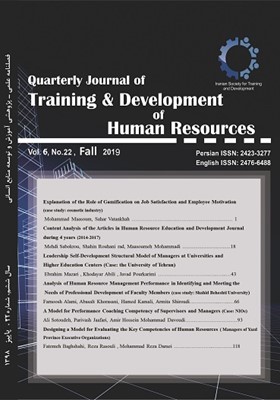Analysis of human resource management performance in identifying and meeting the needs of professional development of faculty members (case study: Shahid Beheshti University)
Subject Areas :Farnoush Aalami 1 , Abasalt Khorasani 2 , Hamed Kamali 3 , Armita Shiroodi 4
1 - دانشگاه شهیدبهشتی
2 - دانشگاه شهید بهشتی
3 -
4 -
Abstract :
by adopting a quantitative approach and using the survey method, the present study sought to analyze the performance of human resources management in identifying and addressing the needs of faculty members' professional development. finally, out of 850 faculty members of the Shahid Beheshti University, 270 members were selected as sample size and were sampled in a relative sampling process. A researcher-made questionnaire was used to collect data. Validity of the questionnaire was confirmed by the experts and its reliability was calculated using Alpha coefficient of Kornbach .89. The data were analyzed in two levels of descriptive and inferential statistics. The findings of the research indicated that the faculty members' knowledge of the needs for research, educational, personal, organizational and ethical development was reported to be high. However, HRM has only been reported to meet the needs of the training professional development and has been reported at a disadvantage in addressing other needs. Therefore, the fundamental gap between the needs of faculty members' professional development and the HRM function is evident in meeting these needs. Such a gap reflects the need to modify and modify HRM procedures in the needs assessment and planning of professional development of Such a gap reflects the need to modify and modify HRM procedures in the needs assessment and planning of professional development of faculty members.faculty members.
|1.zahedi.Sakineh,bazargan(2014). A study of the concept of faculty development and successful experiences about its planning and implementing, higher education letter, vol(6). No(21).pp726)
|2. Baldvin, S. R(2010); “Components of an Effective Faculty Development Program”; Journal of Higher Education, Vol. 46, No. 2, pp. 23-27.
|3. _Shooler, J(2009) ; “Rethinking Faculty Development”;Journal of Higher Education, Vol. 39, No. 1, pp. 35-58.
|4. arasteh,h.,Mahmoodirad,m(1384). Intellectual property: identification, characteristics and growth of elites, Vol(34).No.9.
|5. Arefi,M., Ghahramani, M.(1389). Assessment of job burnout in faculty members of Shahid Beheshti University ,research proposal of education science and psychology faculty.
|6. Jamshidi, L.(1386). The development status of faculty members in Shahid Beheshti University and presenting a model for its continuous improvement, M.A in shahid beheshti university
|7. safari, S. (1388). Designing the educational evaluation model of faculty members toward their development at Shahid Beheshti University, Ph. D thesis, shahid beheshti university
|8. Noorshahi, N.(1393). Effective factors on professional growth of faculty members and providing strategies for improving it, quarterly journal of research and planning in higher education, vol20.No3.pp.90-120.
|9. Yamani, M.(1393). adaptive University: a complex process, Institute for Social and Cultural studies,2edition.
|10. Abbaspour, A.(1381). Comparison of human resource functions of university with strategic human resource management functions, knowledge management, No.58,PP.85-106
|11. Harel,H., Tzafrir, S.S.(1999). The effect of human resource management practices on the perceptions of organizational and market performance of the firm, human resource management,Vol 38, No3.pp185-199.
|12.Armestrong, M. (1384). Strategic human resource management, translated by seyed mohammad A’rabi, David izadi, Cultural Research Office
|13.Bojarczyk Helen (2008). Faculty development for new adjunct faculty: A qualitative investigation of which types of activities most benefit new adjunct faculty at four-year colleges and universities, a dissertation for the degree of Doctor of Philosophy in Education, copyright by proquest ,UMI 3333061.
|14. _Drummond-Young Michele, Noesgaard Charlotte, Maich Matthew Nancy (2010). A Comprehensive Faculty Development model for nursing education, Journal of Professional Nursing, 26 (3), pp: 152-161.
|15.McGregor Petgrave, Dahlia M. (2006). Professional Development Strategies for
Teaching Urban Biology Teachers to Use Concept Maps Effectively, ProQuest.
|16. _Lawler P. A. & King K. P (2000). Planning for effective faculty development: using Adult Learning Strategies, Krieger Publishing Company, United States. p: 3-6
|17.Pourkarimi, J. (1389).The professional development pattern of faculty members of Research Organizations (university Jihad).The Quarterly Journal of Human Resource management of Imam Hussein's comprehensive university.Vol. 1, No. 2 (number 6), pp. 155-141.
|18. Rezaeian, A., Khandan, .A, Ganjali, A., Maradian, H. (1393).The development of faculty members in universities, studied: faculty members of Imam Sadegh University(P). Culture in Islamic University, vol. 4, No. 4
|19. Marzban, Zahra (1388).The necessity of establishing faculty members ' development Center at Shahid Beheshti University.M.Sc. thesis, Shahid Beheshti University.
|20.Ajhadi, Mostafa, Ghourchian, Naderali, Parivash, Jafari, Shafi ' Zadeh, Hamid (1390).Journal of new Thoughts in Education, 7 (3), 12-1.
|21. Fatholah, Sadeghi, Hosseini, Seyed Mahmoud, Rezvanfar, Ahmad; Sharifzadeh, Abolghasem; Morid, Pegah (1388).Analysis of factors influencing the development of professional faculty members of agricultural colleges.Iranian tourism Development and Economics Research, Volume 40, No. 4, pp.77-69.
|22. Brody, C., & Scholar, F. (2007). Success factors for faculty development in Thailand higher education, TUSEF. Retrieved from http://www.fulbrightthai.org.
|23. Murray, J. P (2000). Faculty development in texas two – year community college. Journal of Research and Practice, 24(4)
|24.sarkarayi, M.R. (1393).Improvement of faculty members.Tehran, Institute for Cultural and Social studies, second printing
|25. Bandali, B., Abolghasemi, M., Pardakhtchi, M. H, Rezaeezadeh, M. (1397).Pathology of the Faculty development programs of Shahid Beheshti University.Quarterly Journal of Human Resources Education and development.(5) 18, 53-25.
|26.Jamshidi, L. (1386).The development status of faculty members in Shahid Beheshti University and presenting a model for its continuous improvement.M.A. thesis, Shahid Beheshti University.
|27. _Ghachian, Naderali (1390).The evaluation of faculty members ' improvement in Islamic Azad University, Journal of Leadership and Educational management, (5) 1, 114-95.
|28. Chism, N. (2004). Facuty developmnt in the use of information technologies: A framework for judging when and how to use specific strategics, Journal of Education Quarterly, 27(2),(25 )
|29. rabiyi , A., Zahedi, sh.s, mini,A(1393). Investigating the relationship between human resource culture at national and organizational level with knowledge management
|30.Sarmad, z. Bazargan, A., Hejazi, E.(1394). Research methods In Behavioral science, agah pub.


